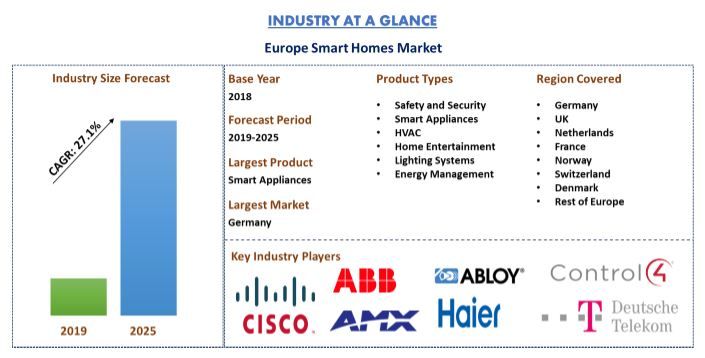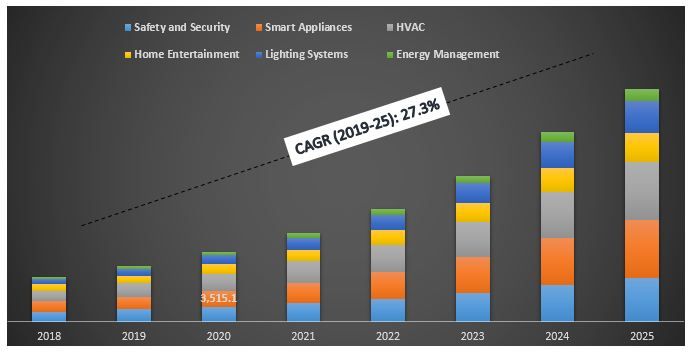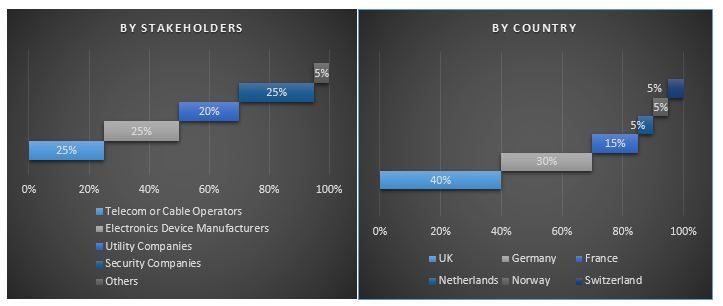- Home
- About Us
- Industry
- Services
- Reading
- Contact Us
Europe Smart Homes Technology Market: Current Analysis and Forecast (2019-2025)
Emphasis on Application (Safety and Security, Smart Appliances, Heating Ventilating, Air Conditioning (HVAC), Home Entertainment, Smart Lighting Systems, Smart Energy Management), Technology (Wireless and Wired Smart Home Technology), End-Users (Residential and Commercials End-Users)
Europe Smart Home Market stood at US$ 9,674.1 million in 2018 and is expected to grow at a CAGR of 27.1% during the forecasted period 2019-2025. The smart home industry in Europe despite being at niche level portrays as the second prominent region in smart home landscape. The smart home industry in the region has witnessed its wide adoption in the past few years, especially in countries such as Germany, UK, the Netherlands, and France. Rapid digitization, high penetration of smartphones, growing need for energy consumption & emission, and rising concern for security & safety constitute as some of the major parameters catalysing the growth of European smart home market. Moreover, swelling aging population has also created ample room for smart revolution in the healthcare sector thereby driving the Europe smart home market. However, the absence of education and knowledge among the consumers about smart devices, consumer’s concern regarding data security, complex installation paired with the high price of smart home appliances are some of the factors which are acting as some of the complex challenges that are hampering the growth of the smart home sector in Europe.
In spite of such challenges, the potential growth for telecom operators, insurance providers and the surge in ageing population at considerable rate are anticipated to attract global players to invest and come up with technologically advanced home appliances products in the respective regions. Increasing investments and development of European companies along with presence of local players such as Hive, Tado, and Netatmo offering smart home products, well suited as per consumer specifications, are further anticipated to propel the market. Undoubtedly, launch of Amazon Echo and Google Home has sparked a wave of adoption of smart devices in Europe as well. New technologies such as voice control and Artificial intelligence not only purpose to offer more convenience to its end users but have resulted in rising consumer awareness to some extent
“Penetration rate of HVAC is estimated to occupy a prominent share of 23.8% in the overall market.”
Europe smart home industry can be segmented across different areas of application which encompasses safety and security, lighting, HVAC, entertainment, smart appliances, and energy management among others. With the change in consumer preferences and promotional marketing of lighting and HVAC appliances, these application areas are likely to be among the top trend during the forecast period.
Europe Smart Home Market Size, by Product 2018-2025 (US$ Mn)
“Wireless technology is expected to grow at a higher CAGR during the analyzed period.”
Based on technologies, the market is segmented into wired and wireless segments. The wireless technology dominates the market and is expected to maintain its dominance by 2025. However, wireless technology is expected to grow at a higher CAGR during the analyzed period. The respective segment is classified into Wi-Fi, Bluetooth, ZigBee, and Z-wave technologies wherein the Wi-Fi smart home technology market was accounted at US$ 5,006.7 million in 2018
“Amongst the end-users, the residential segment holds the major share in the Europe smart home market”
Moreover, the market is further bifurcated into the various end-users, wherein the residential segment holds the prime share in the European smart home market. With the rapid advancement in technologies, changing lifestyles, and rising disposable income of the consumers, mid-range apartments/houses are likely to rule the smart home market by 2025 followed by luxury villas and apartments. The mid-range apartments/houses segment of the residential smart home market generated a revenue of US$ 2,790.2 million in 2018. In addition, among commercial end-users segment, hospitals conquered the market by occupying the lead share in the market, hotels would display maximum CAGR growth of XX% over the forecasted period in the respective market
“Germany dominates the European Smart Home Market, accounting for 20.8% share”
For a deep-dive analysis of the industry, the study is conducted across five regions, including Germany, UK, Netherland, France, Norway, Switzerland, Denmark and rest of Europe. Germany plays chief role in the technological market which was valued at US$ 2,015.3 million in and is estimated to register reasonable compounded growth of 24.1% over the analyzed period. However, Switzerland is expected to witness the highest growth during the analyzed period.
Competitive Landscape-Top 20 Market Players
Some of the major players analyzed during the study include, Haier Electronics, ABB Limited, Acuity Brands, Inc., AMX, LLC, ASSA ABLOY, Cisco Systems, Inc., Control4 Corporation, Crestron Electronics Inc., Deutsche Telekom AG, Emerson Electric Co., General Electric Company, Samsung Electronics Ltd, Honeywell International Inc., IBM Corporation, LG Electronics Inc., Monitronics International Inc., Schneider Electric S.E., Siemens AG, United Technologies Corporation, and Vivint Inc. These companies can pool in investment from their other business to the smart home market and come up with innovative products pertaining to the increasing demand for smart home appliances.
Reasons to buy:
- The smart home market study presents the current market size, trend, forecast until 2025. The analysis presented in the report is a combination of deep-dive secondary research and input from Key Opinion Leader of the industry
- The report presents a quick review of overall industry performance at one glance
- The report covers in-depth analysis of prominent industry peers with primary focus on key business financials, product portfolio, expansion strategies, and recent developments
- Detailed examination of drivers, restraints, key trends and opportunities prevailing in the industry.
- Examination of industry attractiveness with the help of Porter’s Five Forces analysis
- The study comprehensively covers the market across different segments and sub-segments
- The report presents a deep dive regional level analysis of the industry
Customization Options:
UMI understands that you may have your own business need, hence we also provide fully customized solutions to clients. The Europe Smart Home Market can be customized to the regional/country level or any other market segment.
Table of Content
Analysing historical market, estimation of the current market and forecasting the future market for Europe smart home technology were the three major steps to create and analyse the overall adoption rate of smart home technology in the region. Exhaustive secondary research was done to collect the historical market of the technology and overall estimation of the current market. Secondly, to validate these insights, numerous findings and assumptions were taken into consideration. Moreover, exhaustive primary interviews were conducted with industry experts across value chain of the smart home technology in the region. After all the assumption, market sizing and validation of market numbers through primary interviews, top-down approach was employed to forecast the complete market size of smart home technology market at regional or country level scale. Thereafter, market breakdown and data triangulation methods were adopted to estimate and analyse the market size of segments and sub-segments of the technology. Detailed methodology is explained below:
Analysis of Historical Market Size
Step 1: In-Depth Study of Secondary Sources:
Detail secondary study was conducted to obtain the historical market size of the Europe Smart home technology market through company internal sources such as annual report & financial statements of top players, performance presentations, press releases, inventory records, sales figures etc. and external sources including trade journals, news & articles, government publications, economic data, competitor publications, sector reports, regulatory bodies publications, safety standard organizations, third-party database and other creditable publications. For economic data collection, sources such as World Bank, IMF, Trading Economics, Trade Map, and UN Comtrade among others were used.
Step 2: Market Segmentation:
After obtaining historical market size of the overall Europe smart home market, detailed secondary analysis was done to gather historical market insights and share for different segments & sub-segments for the regional smart home technology. Major segments included in the report are technology, application, and end-users. Further analysis was also done for sub-segments of the major segments of regional smart home technology.
Step 3: Factor Analysis:
After acquiring the historical market size of different segments and sub-segments, a detailed factor analysis was conducted to estimate the current market size of the smart home technology in Europe. Factor analysis was conducted using dependent and independent variables such as purchasing power, awareness rate, smartphone penetration, consumer behavior while purchasing smart devices, and satisfaction level of customers etc. Historical trends of the smart home technology and their year-on-year impact on the market size and share in the recent past of different European countries such as Germany, United Kingdom, France, Netherlands, Norway, Switzerland, Denmark and Rest of Europe was analyzed. Demand and supply side scenario was also thoroughly studied.
Current Market Size Estimate & Forecast
Current Market Sizing: Based on actionable insights from the above 3 steps, we arrived at current market size, key players in major applications and markets, market shares of these players of Europe region. All the required percentage shares, splits, and market breakdowns were determined using the above-mentioned secondary approach and were verified through primary interviews.
Estimation & Forecasting: For market estimation and forecast, weightage was assigned to different factors including market dynamics such as drivers & trends, restraints, and opportunities. After analyzing these factors, relevant forecasting techniques i.e. Bottom-up/Top-down was applied to arrive at the market forecast pertaining to 2025 for different segment and sub-segments in different country. The research methodology adopted to estimate the market size encompasses:
- The industry’s market size, in terms of value and rate of adoption of smart home devices
- All percentage shares, splits, and breakdowns of market segments and sub-segments
- Key players in major applications and markets as well as market share of each players. Also, the growth strategies adopted by these players to compete in the ever-growing Europe smart home technology market
Market Size and Share Validation
Primary Research: In-depth interviews were conducted with the Key Opinion Leaders (KOLs) including Top Level Executives (CXO/VPs, Sales Head, Marketing Head, Operational Head, and Regional Head, Country Head etc.) in Europe countries. Primary research findings were summarized, and statistical analysis was performed to prove the stated hypothesis. Input from primary research were consolidated with secondary findings, hence turning information into actionable insights.
Split of Primary Participants in Europe
Market Engineering
Data triangulation technique was employed to complete the overall market engineering process and to arrive precise statistical numbers of each segment and sub-segment pertaining to the smart home technology market in Europe. Data was split into several segments & sub-segments and countries post studying various parameters and trends in the areas of safety & security, smart appliances, consumer appliances, lighting control systems, HVAC, home entertainment & energy management, wireless & wired technology and residential & commercial end-users
Main objective of the Europe Smart Home Technology Market Study
The current & future market trends of the Europe smart home technology are pinpointed in the study. Investors can gain strategic insights to base their discretion for investments from the qualitative and quantitative analysis performed in the study. Current and future market trends would determine the overall attractiveness of the market not only at regional level but also at country level, providing a platform for the industrial participant to exploit the untapped market to benefit as first mover advantage. Other quantitative goal of the studies includes:
- Analyse the current and forecast market size of Europe smart home technology in terms of value
- Analyse the current and forecast market size of different segments and sub-segments of smart home technology. Segments in the study include application, technology and end-users
- Define and describe the technologies and protocols used in smart homes technology
- Anticipate potential risk associated with the technology.
- Customer and competitor analysis, etc.
- Define and analysis of the government regulations for smart home technology in different countries
- Analyse the current and forecast market size of smart home technology, in terms of value for countries including Germany, United Kingdom, France, Netherlands, Norway, Switzerland, Denmark and Rest of Europe region
- Define and analyse the competitive landscape of the Europe smart home technology and the growth strategies adopted by the market players to sustain in the ever-growing market in different countries of the region
Related Reports
Customers who bought this item also bought













